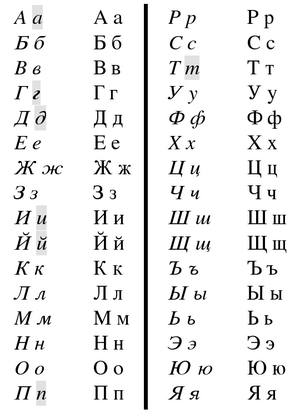Cyrillic alphabet facts for kids
| This article contains Cyrillic text. Without the correct software, you may see question marks or boxes, misplaced vowels or missing conjuncts instead of Cyrillic letters. |
The Cyrillic alphabet is a native Slavic alphabet. Now it is used to write Russian, Ukrainian, Belarusian, Rusyn, Bulgarian, Macedonian and for most South Slavic languages. It was developed in the First Bulgarian Empire during the 10th century and it was required by the Soviet Union for many non-Slavic languages in the Caucasus, Siberia, Central Asia and in Northern Russia to be written in Cyrillic.
Contents
History
Old Church Slavonic was the original language of the Slavic people. Old Church Slavonic was used for Russian Orthodox Church. In the 9th century, two monks named St. Cyril and Methodius were missionaries in Eastern Europe who preached to the Slavic people by inventing Glagolitic, which was early Cyrillic.
During the 18th century, Nikolay Karamzin added the Э, Й and Ё letters.
In 1708, Peter the Great added lowercase forms to the letters
In 1991, Azerbaijan, Turkmenistan and Uzbekistan decided to drop the Cyrillic script and adopt the Latin script.
Related pages
Images for kids
-
Cyrillic Script Monument in Antarctica
-
A page from Азбука (Букварь) (ABC (Reader)), the first Russian language textbook, printed by Ivan Fyodorov in 1574. This page features the Cyrillic alphabet.
See also
 In Spanish: Alfabeto cirílico para niños
In Spanish: Alfabeto cirílico para niños








